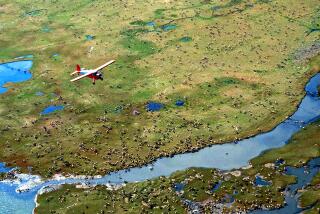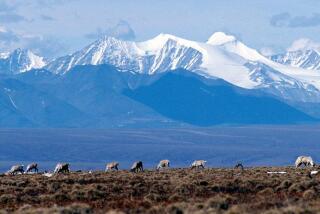Shell opens new oil frontier in Arctic with Chukchi Sea drilling
- Share via
SEATTLE -- A potential new energy frontier opened early Sunday in the U.S. Arctic, as Royal Dutch Shell plumbed a drill bit into the bed of the Chukchi Sea, 70 miles off the coast of northwest Alaska.
The oil company that has spent six years and $4.5 billion trying to launch America’s first offshore oil production in the Arctic announced that its Noble Discoverer had anchored northwest of Alaska’s North Slope and begun drilling the “top hole” of an exploration well. The work was the first step toward drilling a pilot hole that will go about 1,300 feet deep.
The company will not be allowed to plumb deeper into actual hydrocarbon deposits until its oil spill containment barge is completed and on site, a step that could come within the next few weeks, or perhaps not until next year. But Shell officials said that even the preliminary well preparation will put the project on a good course for completion during the 2013 drilling season.
The work that began in the Arctic dawn is the first exploratory drilling in the Arctic since the early 1990s — when far less regulatory scrutiny was placed on the delicate ecosystem of the Far North. The project marks an important milestone for Alaska, where oil production has been declining steadily from the aging oil fields of Prudhoe Bay and Kuparuk on the North Slope.
“This is a big deal. I think it really opens up a new chapter in the oil and gas story in Alaska, and it’s coming at a time when, let’s be honest with ourselves, people are really concerned about the health of the Trans-Alaska [oil] pipeline,” Peter E. Slaiby, vice president of Shell’s Alaska operations, said in an interview Saturday as final drilling preparations were under way.
“Secondly, this is 1,800 jobs this year. I’m not going to jump into any kind of discussion on where we are, but as a nation, these jobs are important. This is potentially a very, very big thing for Alaska and for the nation,” he said.
Drilling of a second well in the Beaufort Sea is on hold pending the aboriginal whaling season of the Inupiat Eskimos of the North Slope. A second drillship, the Kulluk, is on hold near Barrow, Alaska, and could also receive preliminary drilling authorization once whaling is completed.
In any case, Shell officials say they are still a decade away from any oil production in the Arctic. This season’s drilling is for exploration wells, designed to test the size of the undersea oil deposits.
Actual production wells would require another exhaustive round of federal approvals and, most likely, construction of a pipeline to carry the offshore oil bounty into the Trans-Alaska pipeline.
Conservationists have said the upcoming drilling program threatens one of the most fragile environments on Earth with the hazards that come with industrial development. An oil spill in the icy waters of the Arctic, they say, could be far more devastating than most offshore disasters seen thus far.
But for Alaska, which in July was overtaken by North Dakota as the nation’s second-largest oil producer, the news was overwhelmingly welcome.
“After years of federal permitting and litigation delays, we welcome Shell’s progress that will put thousands of Americans to work and lessen our dependence on foreign energy,” Alaska Gov. Sean Parnell said in a statement to the Los Angeles Times.
The U.S. Geological Survey estimates there are 90 billion barrels of recoverable oil and 1.7 trillion cubic feet of natural gas in the Arctic. A warming climate and shrinking polar ice cap has made reaching the bonanza increasingly easier, though Shell remains locked into a short summer timetable for drilling to avoid the hazards of operating once the winter sea ice begins setting in.
The company has asked the U.S. Department of Interior to extend the present Sept. 24 cutoff for drilling in the Chukchi Sea by 18 days, a scenario that would potentially allow engineers to move the oil containment barge into place and complete the first exploratory well. But federal officials have not responded to the request, and the barge remains stuck in Bellingham, Wash., awaiting final U.S. Coast Guard certification.
Coast Guard spokesman Lt. Paul D. Rhynard told The Times on Friday that sea trials for the barge, the Arctic Challenger, are taking place over the weekend, but it was uncertain whether they would be final.
“They still need to get some welding completed on two fuel tanks, and finish testing of several fire extinguishing systems, the general alarm system, operation of fire dampers, and crew drills,” he said.
“Even then, the American Bureau of Shipping also has significant work pending before they will ‘class’ the vessel, which is a requirement for Coast Guard certification,” he said.
Conservationists have fought bitterly to keep the oil industry from moving into the offshore Arctic. They say too little is known about the fragile environment that is one of the most important wildlife nurseries of the Earth.
Despite years of litigation — much of which was found to have merit, and which forced Shell and the Department of Interior back to the drawing tables — Shell has ultimately prevailed, for the most part, in the courts. But more rounds are pending: A coalition of environmental groups, including Oceana, the Center for Biological Diversity, and the Sierra Club, filed suit over the summer challenging the federal government’s approval of an oil spill response plan for the project.
U.S. officials say Shell has agreed to a robust program that includes a flotilla of cleanup vessels pre-positioned near the drill sites and onshore, along with a state-of-the-art capping stack similar to the one that ended the Deepwater Horizon blowout in the Gulf of Mexico and, if all else fails, the containment system aboard the Arctic Challenger that could quickly remove much of the spilled oil and deposit it in a nearby tanker.
But critics say the plan still does not meet the requirements of the oil pollution law passed in the wake of the Exxon Valdez oil spill in Alaska.
They have also been critical of the approval granted this month by the federal Environmental Protection Agency, which allows Shell to operate through next year, though falling somewhat short of original goals for major reductions in nitrogen oxide and ammonia emissions.
“They need to be held to the standards that are in the Clean Air Act. That law has saved hundreds of thousands of lives, and there’s a reason those limits are in there,” said Leah Donahey, western Arctic and oceans program director for the Alaska Wilderness League.
“This is the first time that in offshore waters [in Alaska] they’ll be drilling in about 20 years. We of course are disappointed that this drilling is moving forward without all the conditions that were in the exploration plan,” she said.
Shell has said it will not exceed the original pollution limits contained in its permit during 2012. The company said it has searched widely for better technology and has achieved the maximum emissions controls technically possible, as required under its permit.
Slaiby, the Shell vice president, said even preliminary “top hole” drilling this year will be an important step toward opening the offshore Arctic.
“Drilling is drilling. Because we are really about to go over and demonstrate that we can do what we said we could do. This is really about going out and giving confidence to folks that we have earned our license to operate, and I think that’s going to be a big deal playing out,” he said. “But this is a decadelong process.”
[For the record, 1:40 p.m. Sept. 9: An earlier version of this post said the U.S. Geological Survey estimated there were 1.7 cubic feet of recoverable natural gas in the arctic. Actually, the USGS estimate is 1.7 trillion cubic feet.]
ALSO:
No charges for D.C. officer for alleged threat to first lady
Fluoride: Portland City Council poised to back water treatment
Kellie Pickler’s shaved head: Cancer patients get the message
More to Read
Sign up for Essential California
The most important California stories and recommendations in your inbox every morning.
You may occasionally receive promotional content from the Los Angeles Times.










